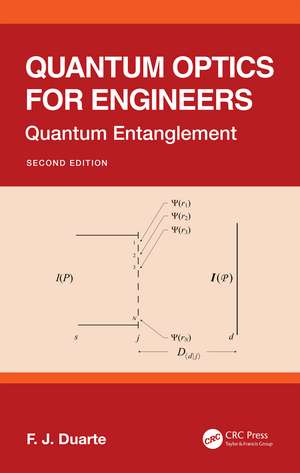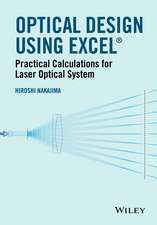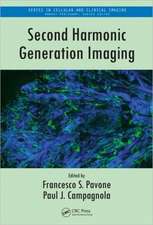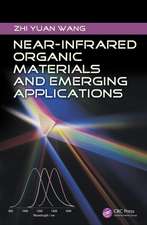Quantum Optics for Engineers: Quantum Entanglement
Autor F.J. Duarteen Limba Engleză Hardback – 29 feb 2024
Features:
- Introduces quantum entanglement via the Dirac–Feynman interferometric principle, free of paradoxes.
- Provides a practical matrix version of quantum entanglement which is highly utilitarian and useful for engineers.
- Focuses on the physics relevant to quantum entanglement and is coherently and consistently presented via Dirac’s notation.
- Illustrates the interferometric quantum origin of fundamental optical principles such as diffraction, refraction, and reflection.
- Emphasizes mathematical transparency and extends on a pragmatic interpretation of quantum mechanics.
| Toate formatele și edițiile | Preț | Express |
|---|---|---|
| Paperback (1) | 461.03 lei 6-8 săpt. | |
| CRC Press – 29 mar 2017 | 461.03 lei 6-8 săpt. | |
| Hardback (2) | 902.29 lei 6-8 săpt. | |
| CRC Press – 29 feb 2024 | 902.29 lei 6-8 săpt. | |
| CRC Press – 25 noi 2013 | 1119.45 lei 6-8 săpt. |
Preț: 902.29 lei
Preț vechi: 1100.35 lei
-18% Nou
Puncte Express: 1353
Preț estimativ în valută:
172.68€ • 179.61$ • 142.55£
172.68€ • 179.61$ • 142.55£
Carte tipărită la comandă
Livrare economică 15-29 aprilie
Preluare comenzi: 021 569.72.76
Specificații
ISBN-13: 9781032499345
ISBN-10: 1032499346
Pagini: 422
Ilustrații: 5 Tables, black and white; 188 Line drawings, black and white; 2 Halftones, black and white; 190 Illustrations, black and white
Dimensiuni: 156 x 234 x 24 mm
Greutate: 0.77 kg
Ediția:2nd edition
Editura: CRC Press
Colecția CRC Press
ISBN-10: 1032499346
Pagini: 422
Ilustrații: 5 Tables, black and white; 188 Line drawings, black and white; 2 Halftones, black and white; 190 Illustrations, black and white
Dimensiuni: 156 x 234 x 24 mm
Greutate: 0.77 kg
Ediția:2nd edition
Editura: CRC Press
Colecția CRC Press
Public țintă
Postgraduate and Professional ReferenceCuprins
Preface
Author’s Biography
Chapter 1 Introduction
14.1 Introduction
14.2 Bell’s Theorem
14.3 Quantum Entanglement Probabilities
14.4 Example
14.5 Discussion
Problems
References
Chapter 15 Quantum Entanglement Probability Amplitude for n = N = 2
Appendix B: Laser Oscillators and Laser Cavities via Dirac’s Notation
Appendix C: Generalized Multiple-Prism Dispersion
Appendix D: Multiple-Prism Dispersion Power Series
Appendix E: N-Slit Interferometric Calculations
Appendix F: Ray Transfer Matrices
Appendix G: Complex Numbers and Quaternions
Appendix H: Trigonometric Identities
Appendix I: Calculus Basics
Appendix J: Poincare’s Space
Appendix K: Physical Constants and Optical Quantities
Index
Author’s Biography
Chapter 1 Introduction
- 1.1 Introduction
- 1.2 Brief Historical Perspective
- 1.3 The Principles of Quantum Mechanics
- 1.4 The Feynman Lectures on Physics
- 1.5 The Photon
- 1.6 Quantum Optics
- 1.7 Quantum Optics for Engineers
- 1.7.1 Quantum Optics for Engineers: Quantum Entanglement, Second Edition
- References
- 2.1 Introduction
- 2.2 Planck’s Equation and Wave Optics
- 2.3 Planck’s Constant h
- 2.3.1 Back to E = h
- Problems
- References
- 3.1 Heisenberg’s Uncertainty Principle
- 3.2 The Wave-Particle Duality
- 3.3 The Feynman Approximation
- 3.1.1 Example
- 3.4 The Interferometric Approximation
- 3.5 The Minimum Uncertainty Principle
- 3.6 The Generalized Uncertainty Principle
- 3.7 Equivalent Versions of Heisenberg’s Uncertainty Principle
- 3.7.1 Example
- 3.8 Applications of the Uncertainty Principle in Optics
- 3.8.1 Beam Divergence
- 3.8.2 Beam Divergence in Astronomy
- 3.8.3 The Uncertainty Principle and the Cavity Linewidth Equation
- 3.8.4 Tuning Laser Microcavities
- 3.8.5 Nanocavities
- Problems
- References
- 4.1 Dirac’s Notation in Optics
- 4.2 The Dirac–Feynman Interferometric Principle
- 4.3 Interference and the Interferometric Probability Equation
- 4.3.1 Examples: Double-, Triple-, Quadruple-, and Quintuple-Slit Interference
- 4.3.2 Geometry of the N-Slit Quantum Interferometer
- 4.3.3 The Diffraction Grating Equation
- 4.3.4 N-Slit Interferometer Experiment
- 4.4 Coherent and Semi-Coherent Interferograms
- 4.5 The Interferometric Probability Equation in Two and Three Dimensions
- 4.6 Classical and Quantum Alternatives
- Problems
- References
- 5.1 Introduction
- 5.2 Interference and Diffraction
- 5.2.1 Generalized Diffraction
- 5.2.2 Positive Diffraction
- 5.3 Positive and Negative Refraction
- 5.3.1 Focusing
- 5.4 Reflection
- 5.5 Succinct Description of Optics
- 5.6 Quantum Interference and Classical Interference
- Problems
- References
- 6.1 Useful Identities
- 6.1.1 Example
- 6.2 Linear Operations
- 6.2.1 Example
- 6.3 Extension to Indistinguishable Quanta Ensembles
- Problems
- References
- 7.1 Interference à la Dirac
- 7.2 The N-Slit Interferometer
- 7.3 The Hanbury Brown–Twiss Interferometer
- 7.4 Beam-Splitter Interferometers
- 7.4.1 The Mach–Zehnder Interferometer
- 7.4.2 The Michelson Interferometer
- 7.4.3 The Sagnac Interferometer
- 7.4.4 The HOM Interferometer
- 7.5 Multiple-Beam Interferometers
- 7.6 The Ramsey Interferometer
- Problems
- References
- 8.1 Introduction
- 8.2 Theory
- 8.3 N-Slit Interferometer for Secure Free-Space Quantum Communications
- 8.4 Interferometric Characters
- 8.5 Propagation in Terrestrial Free Space
- 8.5.1 Clear-Air Turbulence
- 8.6 Additional Applications
- 8.7 Discussion
- Problems
- References
- 9.1 Introduction
- 9.2 A Heuristic Explicit Approach to Schrödinger’s Equation
- 9.3 Schrödinger’s Equation via Dirac’s Notation
- 9.4 The Time-Independent Schrödinger Equation
- 9.4.1 Quantized Energy Levels
- 9.4.2 Semiconductor Emission
- 9.4.3 Quantum Wells
- 9.4.4 Quantum Cascade Lasers
- 9.4.5 Quantum Dots
- 9.5 Nonlinear Schrödinger Equation
- 9.6 Discussion
- Problems
- References
- 10.1 Introduction
- 10.2 The Classical Action
- 10.3 The Quantum Link
- 10.4 Propagation through a Slit and the Uncertainty Principle
- 10.4.1 Discussion
- 10.5 Feynman Diagrams in Optics
- Problems
- References
- 11.1 Introduction
- 11.2 Introduction to Vector and Matrix Algebra
- 11.2.1 Vector Algebra
- 11.2.2 Matrix Algebra
- 11.2.3 Unitary Matrices
- 11.3 Pauli Matrices
- 11.3.1 Eigenvalues of Pauli Matrices
- 11.3.2 Pauli Matrices for Spin One-Half Particles
- 11.3.3 The Tensor Product
- 11.4 Introduction to the Density Matrix
- 11.4.1 Examples
- 11.4.2 Transitions Via the Density Matrix
- 11.5 Quantum Operators
- 11.5.1 The Position Operator
- 11.5.2 The Momentum Operator
- 11.5.3 Example
- 11.5.4 The Energy Operator
- 11.5.5 The Heisenberg Equation of Motion
- Problems
- References
- 12.1 Introduction
- 12.2 Maxwell Equations
- 12.2.1 Symmetry in Maxwell Equations
- 12.3 Polarization and Reflection
- 12.3.1 The Plane of Incidence
- 12.4 Jones Calculus
- 12.4.1 Example
- 12.5 Polarizing Prisms
- 12.5.1 Transmission Efficiency in Multiple-Prism Arrays
- 12.5.2 Induced Polarization in a Double-Prism Beam Expander
- 12.5.3 Double-Refraction Polarizers
- 12.5.4 Attenuation of the Intensity of Laser Beams Using Polarization
- 12.6 Polarization Rotators
- 12.6.1 Birefringent Polarization Rotators
- 12.6.2 Example
- 12.6.3 Broadband Prismatic Polarization Rotators
- 12.6.4 Example
- Problems
- References
- 13.1 Introduction
- 13.2 Linear Polarization
- 13.2.1 Example
- 13.3 Polarization as a Two-State System
- 13.3.1 Diagonal Polarization
- 13.3.2 Circular Polarization
- 13.4 Density Matrix Notation
- 13.4.1 Stokes Parameters and Pauli Matrices
- 13.4.2 The Density Matrix and Circular Polarization
- 13.4.3 Example
- Problems
- References
14.1 Introduction
14.2 Bell’s Theorem
14.3 Quantum Entanglement Probabilities
14.4 Example
14.5 Discussion
Problems
References
Chapter 15 Quantum Entanglement Probability Amplitude for n = N = 2
- 15.1 Introduction
- 15.2 The Dirac–Feynman Probability Amplitude
- 15.3 The Quantum Entanglement Probability Amplitude
- 15.4 Identical States of Polarization
- 15.5 Entanglement of Indistinguishable Ensembles
- 15.6 Discussion
- Problems
- References
- 16.1 Introduction
- 16.2 Quantum Entanglement Probability Amplitude for n = N = 4
- 16.3 Quantum Entanglement Probability Amplitude for n = N = 8
- 16.4 Quantum Entanglement Probability Amplitude for n = N = 16
- 16.5 Quantum Entanglement Probability Amplitude for n = N = 21, 22, 23, … 2r
- 16.5.1 Example
- 16.6 Summary
- Problems
- References
- 17.1 Introduction
- 17.2 Quantum Entanglement Probability Amplitude for n = N = 3
- 17.3 Quantum Entanglement Probability Amplitude for n = N = 6
- 17.4 Discussion
- Problems
- References
- 18.1 Introduction
- 18.2 Quantum Entanglement Probability Amplitudes
- 18.3 Quantum Entanglement via Pauli Matrices
- 18.3.1 Example
- 18.3.2 Pauli Matrices Identities
- 18.4 Quantum Entanglement via the Hadamard Gate
- 18.5 Quantum Entanglement Probability Amplitude Matrices
- 18.6 Quantum Entanglement Polarization Rotator Mathematics
- 18.7 Quantum Mathematics via Hadamard’s Gate
- 18.8 Reversibility in Quantum Mechanics
- Problems
- References
- 19.1 Introduction
- 19.2 Interferometric Computer
- 19.3 Classical Logic Gates
- 19.4 von Neumann Entropy
- 19.5 Qbits
- 19.6 Quantum Entanglement via Pauli Matrices
- 19.7 Rotation of Quantum Entanglement States
- 19.8 Quantum Gates
- 19.8.1 Pauli Gates
- 19.8.2 The Hadamard Gate
- 19.8.3 The CNOT Gate
- 19.9 Quantum Entanglement Mathematics via the Hadamard Gate
- 19.9.1 Example
- 19.10 Multiple Entangled States
- 19.11 Discussion
- Problems
- References
- 20.1 Introduction
- 20.2 Quantum Cryptography
- 20.2.1 Bennett and Brassard Cryptography
- 20.2.2 Quantum Entanglement Cryptography Using Bell’s Theorem
- 20.2.3 All-Quantum Quantum Entanglement Cryptography
- 20.3 Quantum Teleportation
- Problems
- References
- 21.1 Introduction
- 21.1.1 The Two Realms of Quantum Mechanics
- 21.2 The Interferometric Irreversible Measurements
- 21.2.1 The Quantum Measurement Mechanics
- 21.2.2 Additional Irreversible Quantum Measurements
- 21.3 Quantum Non-demolition Measurements
- 21.3.1 Soft Probing of Quantum States
- 21.4 Soft Intersection of Interferometric Characters
- 21.4.1 Comparison between Theoretical andbMeasured N-Slit Interferograms
- 21.4.2 Soft Interferometric Probing
- 21.4.3 The Mechanics of Soft Interferometric Probing
- 21.5 On the Quantum Measurer
- 21.5.1 External Intrusions
- 21.6 Quantum Entropy
- 21.7 Discussion
- Problems
- References
- 22.1 Introduction
- 22.2 Fundamental Principles of Quantum Mechanics
- 22.3 Probability Amplitudes
- 22.3.1 Probability Amplitude Refinement
- 22.4 From Probability Amplitudes to Probabilities
- 22.4.1 Interferometric Cascade
- 22.5 Nonlocality of the Photon
- 22.6 Indistinguishability and Dirac’s Identities
- 22.7 Quantum Entanglement and the Foundations of Quantum Mechanics
- 22.8 The Dirac–Feynman Interferometric Principle
- Problems
- References
- 23.1 Introduction
- 23.2 Einstein Podolsky and Rosen (EPR)
- 23.3 Heisenberg’s Uncertainty Principle and EPR
- 23.4 Quantum Physicists on the Interpretation of Quantum Mechanics
- 23.4.1 The Pragmatic Practitioners
- 23.4.2 Bell’s Criticisms
- 23.5 On Hidden Variable Theories
- 23.6 On the Absence of ‘The Measurement Problem’
- 23.7 The Physical Bases of Quantum Entanglement
- 23.8 The Mechanisms of Quantum Mechanics
- 23.8.1 The Quantum Interference Mechanics
- 23.8.2 The Quantum Entanglement Mechanics
- 23.9 Philosophy
- 23.10 Discussion
- Problems
- References
Appendix B: Laser Oscillators and Laser Cavities via Dirac’s Notation
Appendix C: Generalized Multiple-Prism Dispersion
Appendix D: Multiple-Prism Dispersion Power Series
Appendix E: N-Slit Interferometric Calculations
Appendix F: Ray Transfer Matrices
Appendix G: Complex Numbers and Quaternions
Appendix H: Trigonometric Identities
Appendix I: Calculus Basics
Appendix J: Poincare’s Space
Appendix K: Physical Constants and Optical Quantities
Index
Notă biografică
Francisco Javier "Frank" Duarte is a laser physicist and author/editor of several books on tunable lasers and quantum optics. His research on physical optics, quantum optics, and laser development has won several awards. He has made numerous original contributions to tunable lasers, multiple-prism optics, quantum interferometry, and quantum entanglement. Dr. Duarte was elected Fellow of the Australian Institute of Physics in 1987 and Fellow of the Optical Society (Optica) in 1993. He has received the Engineering Excellence Award (1995), for the invention of the N-slit laser interferometer, and the David Richardson Medal (2016) for his seminal contributions to the physics of narrow-linewidth tunable lasers and the theory of multiple-prism arrays for linewidth narrowing and laser pulse compression.
Descriere
This is an updated, and extended version of its first edition. New features include transparent interferometric derivation of the physics for quantum entanglement devoid of mysteries and paradoxes. It also provides utilitarian matrix version of quantum entanglement for engineering applications.
Recenzii
"Duarte's book is a welcome addition to the family of optics texts because he stresses fundamental connections between classical and quantum optics. His review of the bedrock theory and experiments of several of the founders of quantum physics provides an instructive transition to recent developments in quantum optics, such as photon entanglement. Perhaps the most appealing aspect of this book is the treatment of classical optical concepts and phenomena in terms of a quantum formalism...Both graduate students and the experienced researcher will find this treatment of quantum optics to be illuminating and valuable...I look forward to having a copy in my personal library."
—Professor J. Gary Eden, Electrical and Computer Engineering, University of Illinois
"Quantum Optics for Engineers is an original and unique book that describes classical and quantum optical phenomena, and the synergy between these two subjects, from an interferometric perspective. Dirac’s notation is used ... [to] provide a lucid explanation of quantum polarization entanglement. The book will serve engineers with a minimum knowledge of quantum mechanics ... to understand modern experiments with lasers, optical communications, and the intriguing world of quantum entanglement."
––Ignacio E. Olivares, Universidad de Santiago de Chile
"Quantum Optics for Engineers provides a transparent and succinct description of the fundamentals of quantum optics using Dirac’s notation and ample illustrations. Particularly valuable is the explanation and elucidation of quantum entanglement from an interferometric perspective. The cohesiveness provided by the unified use of Dirac’s notation, emphasizing physics rather than mathematics, is particularly useful for those trained in engineering. This will be a valuable asset to any optical engineer’s library."
––Anne M. Miller, RR Donnelley, USA
"This book is a concise and comprehensive presentation of numerous fundamental concepts related to the light nature and its interaction with matter. A very structured and logical route reveals step by step the rigorous theory of quantum optics. To some extent, the whole project can be fairly defined as unique. One of the heaviest tools in quantum optics, operator representation, is introduced in a very clear and straightforward way. Nature foundations and rather complicated mathematical tools are brought in a very elegant manner such that readers suddenly find themselves as experts in areas they would consider untouchable magic. The intriguing world of quantum entanglement is revealed via many practical examples."
––Sergei Popov, Royal Institute of Technology, Sweden
—Professor J. Gary Eden, Electrical and Computer Engineering, University of Illinois
"Quantum Optics for Engineers is an original and unique book that describes classical and quantum optical phenomena, and the synergy between these two subjects, from an interferometric perspective. Dirac’s notation is used ... [to] provide a lucid explanation of quantum polarization entanglement. The book will serve engineers with a minimum knowledge of quantum mechanics ... to understand modern experiments with lasers, optical communications, and the intriguing world of quantum entanglement."
––Ignacio E. Olivares, Universidad de Santiago de Chile
"Quantum Optics for Engineers provides a transparent and succinct description of the fundamentals of quantum optics using Dirac’s notation and ample illustrations. Particularly valuable is the explanation and elucidation of quantum entanglement from an interferometric perspective. The cohesiveness provided by the unified use of Dirac’s notation, emphasizing physics rather than mathematics, is particularly useful for those trained in engineering. This will be a valuable asset to any optical engineer’s library."
––Anne M. Miller, RR Donnelley, USA
"This book is a concise and comprehensive presentation of numerous fundamental concepts related to the light nature and its interaction with matter. A very structured and logical route reveals step by step the rigorous theory of quantum optics. To some extent, the whole project can be fairly defined as unique. One of the heaviest tools in quantum optics, operator representation, is introduced in a very clear and straightforward way. Nature foundations and rather complicated mathematical tools are brought in a very elegant manner such that readers suddenly find themselves as experts in areas they would consider untouchable magic. The intriguing world of quantum entanglement is revealed via many practical examples."
––Sergei Popov, Royal Institute of Technology, Sweden



















